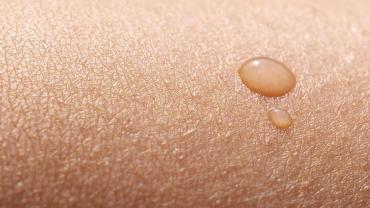
Vitamin A has long been recognized as a major contributor to skin health. Deficiency may manifest as phrynoderma or hyperkeratosis at the hair follicles, although these may also be consequences of malnutrition in general, and more specifically of essential fatty acids. Let’s take a closer look at the role of this critical fat-soluble nutrient in supporting healthy skin.
“Vitamin A” refers to a host of related compounds called retinoids—retinol, retinal, and retinoic acid—with retinal and retinoic acid being the “active” forms. Most of the body’s vitamin A is stored in the liver, as retinyl esters. True vitamin A occurs only in animal foods, as retinol. The vitamin A precursors in plant foods are provitamin A carotenoids, which include β-carotene, α-carotene, and β-cryptoxanthin. These can all be converted to retinol in the body, but other commonly consumed carotenoids such as lycopene, lutein, and zeaxanthin cannot.
While the aforementioned provitamin A carotenoids can be converted into vitamin A, the efficacy of this is limited and varies widely among individuals, influenced by various metabolic and hormonal abnormalities. Absorption of β-carotene from plant foods ranges from 5% to 65% in humans. The bioavailability and vitamin A equivalency of carotenoids are highly variable and are impacted by numerous factors related to the foods themselves and to the health status of the individual consuming them. These include the food matrix, processing techniques, the concentration of the carotenoid, and the amounts of dietary fat, fiber, and preformed vitamin A in the diet, as well as an individual’s vitamin A status, gut integrity, and genetic polymorphisms that affect carotenoid metabolism. Some individuals may be able to synthesize sufficient vitamin A from carotenoid precursors, but others may be better served by getting pre-formed vitamin A from animal foods and/or supplementation and should not rely solely on a high intake of provitamin A carotenoids.
Zeroing in on skin health, akin to the “gut-brain axis,” researchers have identified a gut-skin axis. If immune activity originating in the gut affects the skin—and research indicates it does—then it’s possible orally ingested vitamin A (as opposed to topical) may be influencing skin status by modulating intestinal flora and supporting a healthy immune response in the gut.
Beyond the gut, vitamin A appears potentially to serve an immune-supporting function in the skin, itself. Research in rodents indicates that resistin and resistin-like proteins and peptides in the skin exert bactericidal and antimicrobial properties that are vitamin A-dependent, leading researchers to use the phrase “vitamin-A-dependent antibacterial skin defense,” at least as it applies to mice. Research suggests that “fat-soluble vitamins appear to be of particular importance for the expression of lipophilic skin antimicrobial proteins.”
Vitamin A-derived retinoids have been used for almost 80 years to treat acne vulgaris, and newer applications include managing photoaging/photodamage. It is generally accepted that topical retinoids enter skin cells via non-receptor mediated endocytosis. They reach the nucleus, bind to specific DNA sequences known as “retinoid response elements,” and regulate the transcription of “retinoid-sensitive genes.” Numerous individual mechanisms underlie the beneficial actions of retinoids on skin. These include increased collagen synthesis and reduced collagen degradation, increased epidermal differentiation, inhibition of melanosome transfer, enhanced keratinocyte shedding, and several more, with the end results being improvements in coarse wrinkles, increased skin smoothness, decreased roughness, and improvement of skin discoloration. Retinoids also strengthen the protective function of the epidermis and reduce trans-epidermal water loss, potentially resulting in skin with a more youthful appearance.
Another application for vitamin A and retinoid compounds is in wound healing:
“In wounded tissue, vitamin A stimulates epidermal turnover, increases the rate of re-epithelialization, and restores epithelial structure. Retinoids have the unique ability to reverse the inhibitory effects of anti-inflammatory steroids on wound healing. In addition to its role in the inflammatory phase of wound healing, retinoic acid has been demonstrated to enhance production of extracellular matrix components such as collagen type I and fibronectin, increase proliferation of keratinocytes and fibroblasts, and decrease levels of degrading matrix metalloproteinases.” (Source)
Topical retinoids influence proliferation and differentiation of keratinocytes and increase follicular epithelial turnover. These and other mechanisms by which retinoids affect skin cells may contribute to the protective role vitamin A appears to offer against certain types of skin cancer. A prospective study using data from two large epidemiological surveys found that increased intake of vitamin A is associated with decreased risk of cutaneous squamous cell carcinoma.
Overt vitamin A deficiency is rare in the industrialized world, but certain populations are at increased risk, such as those with malabsorptive conditions, pancreatic insufficiency, or those who take medications that interfere with fat absorption. Patients who have undergone certain forms of bariatric surgery may be at particularly elevated risk. In a study evaluating 170 bariatric surgery patients from medical centers in New York and Brisbane, Australia, the incidence of vitamin A deficiency was an alarming 69%. There have been numerous reports of permanent ocular damage due to hypovitaminosis A in these circumstances, including deterioration to legal blindness. Some of the issues stemming from inadequate intake or impaired absorption of vitamin A may take several years to develop, so these patients should be monitored for nutrient status over the long term.